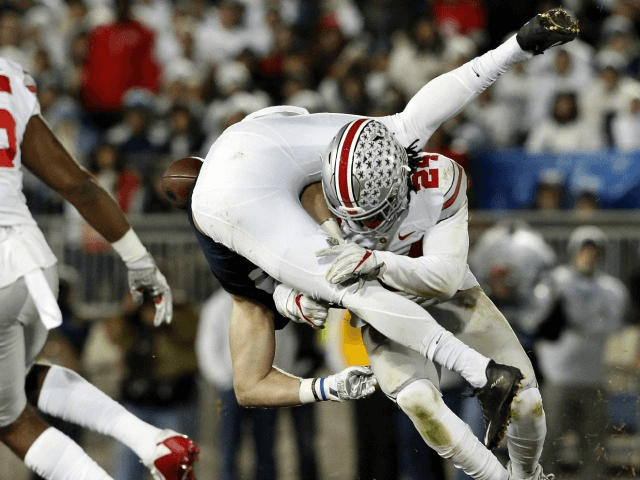Zack Langston died of a self-inflicted gunshot wound three years ago far away from a football field. On Saturday, The Guardian published an article about the former Pittsburg State linebacker linking his suicide to the gridiron.
In one paragraph, The Guardian depicts Langston as “hauled off the field on a stretcher.” Five paragraphs later, the piece notes the player shooting himself. The connection between the two events—a medical event involving dehydration and a guy who once played football at a Division II killing himself—never receives an adequate explanation. But clearly the writer wants the reader to link them.
Most rely on science to show cause and effect. But when the science does not exist, insinuation becomes a popular option.
The existing science on suicide and football actually tends to support the opposite of the conclusion advanced to a global audience in The Guardian about America’s game. When National Institute on Occupational Safety and Health (NIOSH) performed a mortality study on athletes who competed for five or more seasons in the National Football League between 1959 and 1988, the scientists found lower death rates in 14 of 17 killer categories for the retired players. One of the most dramatic findings involved suicide. The NIOSH doctors found that the regular Joes killed themselves at rate about a two-and-a-half-times that of the Pros.
While the journalists fixate on anecdotes such as the suicides of high-profile players such as Junior Seau and Dave Duerson, scientists examine the data.
“NFL players are at decreased risk, not increased risk, for completed suicide relative to the general population,” Grant Iverson of Harvard Medical School’s Department of Physical Medicine and Rehabilitation wrote in British Journal of Sports Medicine. Iverson notes that suicide also affects baseball players, weightlighters, shot-putters, and other athletes. But the media obsesses over athletes who kill themselves when those athletes once played football.
“Finding evidence of the neuropathology of CTE [chronic traumatic encephalopathy] in the brains of former athletes who complete suicide is a provocative but not statistically compelling source of evidence,” Iverson concludes. “The putative causal link in individual cases represents circular reasoning (ie, petitio principii).”
No randomized longitudinal or cross-sectional study exists showing a connection between CTE, a debilitating brain disease, and football—or any sport for that matter. This is because no such study has been attempted. So, we don’t know the prevalence of CTE among the general population or among football populations. We don’t know what causes it. We don’t know that it leads to CTE, and although one cannot fault educated guesses that stipulate that football can lead to damage the leap that football leads to suicide runs up against science contradicting that hypothesis.
Many people who do not play football kill themselves without the media linking their demises to their vocations. Bears defensive back Dave Duerson, for instance, experienced home foreclosure, bankruptcy, and the failure of a marriage. Hall of Famer Junior Seau drank five nights a week, gambled away a fortune, and watched the demise of the San Diego steakhouse bearing his name. But they killed themselves, articles insist, as a result of football rather than for the common reasons—marital troubles, financial issues, chemical dependence, etc.—that propel people outside of football to end their lives.
A similar phenomenon surrounds media coverage Zack Langston. The Guardian piece notes the 26-year-old began throwing chairs at a restaurant and disturbed his family by buying several guns. Did his troubling behavior, independent of the sport he played, lead to his suicide? Or, did football bring about the troubling behavior that brought about his demise? The Guardian seems convinced of the latter, even though it also seems convinced that football brings about CTE, which brings about suicide. The scientific data, nonexistent on whether sports cause CTE, undermine the idea that CTE brings about suicide—the rate of suicide among NFL players, according to NIOSH, does not come close to the rate among their peer group in society.
The NFL did not ask for this study. The players’ union did. And hacks did not conduct it. NIOSH did. It relies not so much on a sample group but on every pension-vested NFL player who competed between 1959 and 1988. It is comprehensive.
Like the media, Langston’s family seems convinced that football harms its players. And if the reasons provided by celebrity CTE doctors failed to persuade the loved ones of late players, then millions of reasons exist in the current lawsuit against the NCAA, which Langston’s family has joined.
“I’lI drive by football fields – middle schools – and I see these boys out practicing and it just makes me ill,” Langston’s mother Nicki tells The Guardian. “The first time I saw it this season,” she confesses, “I wanted to jump out of my car and say, ‘Do you know what you’re doing?’”
One asks the same question of football’s detractors.

COMMENTS
Please let us know if you're having issues with commenting.